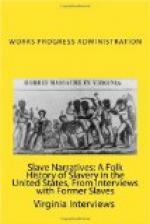“My grandfather on my mother’s side was named Charlie Hall. He married into the Madden family. He belonged to the Halls before he married. Old man Charlie, his master, had a plantation that wasn’t far from the Madden’s plantation. In those days, if you met a girl and fell in love with her, you could git a pass and go to see her if you wanted to. You didn’t have to be on the same plantation at all. And you could marry her and go to see her, and have children by her even though you belonged to different masters. The Maddens never did buy Hall. Grandma never would change her name to Hall. He stayed at my house after we married, stayed with me sometimes, and stayed with his other son sometimes.
“My mother was born a Madden. She was born right at Madden’s place. When grandma married Hall, like it is now, she would have been called Hall. But she was born a Madden and stayed Madden and never did change to her husband’s name. So my mother was born a Madden although her father’s name was Hall.
“I don’t know what sort of man Mabe was, and I only know what my parents said about John. They said he was a good man and I have to say what they said. He didn’t let nobody impose on his niggers. Pateroles did git after them and bring them in with the hounds, but when they got in, that settled it. Madden never would allow white people to beat on his niggers.
“They tried to git my daddy out so that they could whip him, but they couldn’t catch him. They shot him—the pateroles did—but he whipped them. My daddy was a coon. I mean he was a good man.
Early Life
“My brother was big enough to mind gaps. That was in slavery times. They had good fences around the field. They didn’t have gates like they do now. They had gaps. The fence would zigzag, and the rails could be lifted down at one section, and that would leave a gap. If you left a gap, the stock would go into the field. When there was a gap, my brother would stay in it and keep the stock from passing. When the folks would come to dinner, he would go in and eat dinner with them just as big as anybody. When they would leave, the gap would stay down till night. It stayed down from morning till noon and from one o’clock till the men come in at night. The gap was a place in the rails like I told you where they could take down the rails to pass. It took time to lay the rails down and more time to place then back up again. They wouldn’t do it. They would leave them down till they come back during the work hours and a boy that was too small to do anything else was put to mind them. My brother used to do that and I would keep him company. When I heard old master coming there, I’d be gone, yes siree. I would see him when he left the house and when he got to the gap, I would be home or at my grandfather’s.




